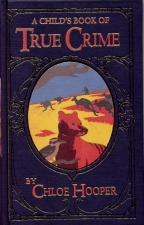A Child's Book of True Crime
Chloe Hooper
Knopf / Random House
Australian Hardcover First
ISBN 1-740-51120-4
Publication Date: 02-21-2002
238 Pages; £12.99
Date Reviewed: 07-14-03
Reviewed by: Rick Kleffel © 2003

REFERENCES
COLUMNS
|
|
|
A Child's Book of True CrimeChloe HooperKnopf / Random HouseAustralian Hardcover FirstISBN 1-740-51120-4Publication Date: 02-21-2002238 Pages; £12.99Date Reviewed: 07-14-03Reviewed by: Rick Kleffel © 2003 |
|
|
REFERENCES |
COLUMNS |
The wisdom of children seems deeper, more important when compared to the greedy selfishness of adults. Adults caught in the rush of an erotic obsession are particularly childish. Children show the ability to display a casual viciousness; pulling the legs off of bugs, burning ants with a magnifying glass. In adults, viciousness manifests itself as horrific and often pointless violence. The contrasts and comparisons between adults and children caught in vicinity of a crime can make for compelling, fascinating reading. But when the storyteller is an addled adult who can't be relied upon to know what's obviously best for herself, the details that would make the comparisons convincing lose their impact. In the heatwave of a sexual infatuation, they can be concealed by the fallout of wanton lust. Chloe Hooper's first novel, 'A Child's Book of True Crime', has some captivating ideas that are nearly capsized in a sea of passionate fixation. Readers who enjoy dangerous erotica will find Hooper's narrator Kate Byrne a gripping girl-guide to subtle terror and deep philosophy. Others may wish that there were less groping and moping and more thinking than slinking.
The set-up of 'A Child's Book of True Crime' is nothing less than brilliant. Young schoolteacher Kate Byrne is having an affair with the Thomas Marne, parent of one of her bright but troubled students, Lucien Marne. Lucien's mother, Veronica Marne has just written the popular but controversial 'Murder at Black Swan Point', a true-crime account of Margot Harvey, who brutally murdered Ellie Siddell, her husband's lover nearly 20 years ago. When Lucien's own illustrations begin show signs of violence, Kate becomes concerned for her safety as much as his. But she's still hot to trot. Interspersed in her narrative are excerpts from a children's book in which cuddly examples of Tasmanian wildlife are called upon to solve a murder very much like that of Ellie Siddell.
'A Child's Book of True Crime' is neither a standard mystery nor is it a standard novel. Plot and characterization take a back seat to Kate's overheated musings. She tells the story in the first person, except when she's telling the story in the third person as if she were narrating her own imagined version of the murder of Ellie Siddell. It quickly becomes apparent that Kate is not just an unreliable narrator -- she's actively unstable. Just how far she'll get in her unstable state seems questionable. And indeed, she doesn't get too far. Once the novel has deployed the excellent setup, there's no follow-through.
Instead, we get unreliable Kate and her tensely erotic adventures contrasted with lots of very well-done research about how kids conceive of the adult world and their own thoughts on matters of philosophical import. While Kate wanders about in a practically infantile state, pretending to envision various permutations of what might really have happened at Black Swan Point 20 years ago, the author lets fly the best portions of the book. Hooper is clearly a talented writer and lots of the prose is quote-worthy. But in choosing her narrator to be the obsessed and naïve Kate, she manages to bring the plot to a grinding halt and obscure her better instincts. To be sure, there are lots of pithy thoughts about children and innocence, violence and obsession. But unless you're hot to trot for Kate herself -- and Hooper does make her sound like a dish best served hot -- her personal inquest into the versions of violence on Black Swan Point will leave the reader cold.
Readers who enjoy hothouse erotic writing will find this novel a compelling read. The interspersed excerpts of 'A Child's Book of True Crime' are wonderful, as are all the musings of children on violence, innocence, God and science. Hooper also marshals an array of fascinating statistics about children's perceptions of the adult world. The contrast between the adult-seeming children and the childish antics of the adults often plays extremely well. But the ambiguity that Hooper is working towards plays against the expectations of a novel whose subject is passionate murder. While she successfully achieves the effects she appears to be attempting, it's a success that will leave readers who like their hot-blooded fiction to be red-blooded as well wanting. In her character study the addled and ultimately innocent child is not the student. But the reader may feel as manipulated as the character. Please, please - put down the knife.